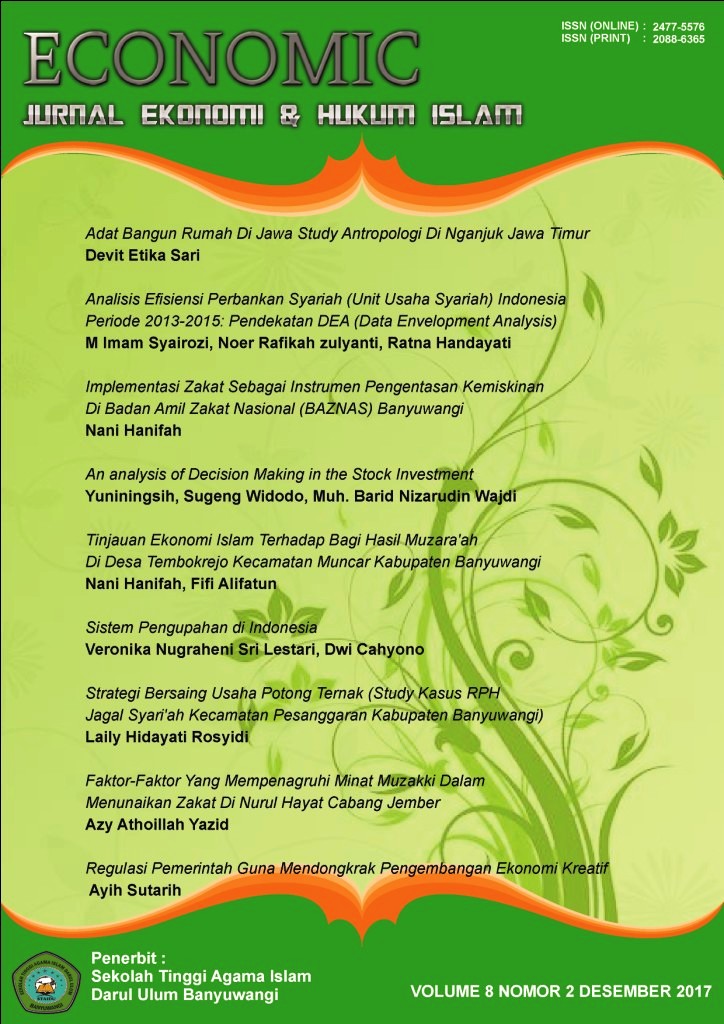An analysis of Decision Making in the Stock Investment
Keywords:
decision making, investment, loss aversion, risk taking.
Abstract
The research objective is to test how much risk investors are willing to take when making their investment associated with the loss aversion, in terms of the risk taking behavior in relation with that of the loss aversion. The later, the loss aversion is treated as the independent variable reviewed from the two sides of the gain and loss domain. When investors are in loss aversion within the gain domain, they tend to have a lower risk taking behavior than that of the loss domain. Such tendency of investor’s behavior differences in those two different domains is described in a hypothetical value function (Kahneman and Tversky, 1979). ANOVA Test is applied to determine the risk taking behavioral differences in the two domains toward the loss aversion. Hypothesis test results with the alpha index indicate that investors, when in the loss aversion of the gain domain, have a lower risk taking than that of the loss aversion in the loss domain. Meanwhile, using post hoc for significant test results in that the loss aversion has a significant influence for the risk taking decision making in investment, particularly in that of the stocks.References
Fama, Eugene F, (1970). Efficient Capital Markets : A Review of Theory and Empirical Work Author(s). The Journal of Finance, Vol. 25, No. 2, Papers and Proceedings of the Twenty-Eighth Annual Meeting of the American Finance Association New York, N.Y. December, 28-30, 1969 (May, 1970), pp. 383-417 Published by: Blackwell Publishing for the American Finance Association Stable URL: http://www.jstor.org/stable/2325486 Accessed: 30/03/2010 21:28 Your use of the JSTOR archive indicates your acceptance of JSTOR's
Gu Seo, M., Goldfare,B., and Barrett,F.L. (2010). Affect And The Framing Effect Within Individuals Over Time: Risk Taking In A Dynamic Investment Simulation, Academy of Management Journal, 2010, Vol. 53, No. 2, 411–431.
Haigh, S.M., and List.A.J. (2005). Do Professional Traders Exhibit Myopic Loss Aversion? An Experimental Analysis. The Journal Of Finance. Vol. IX, No 1. February 2005
Kahneman,D and Tversky,A. (1979). Prospeck Theory :An Analysis of Decision Under Risk. Econometrica 47(2):263-291
Levi S.J. (1992). An Introduction to Prospect Theory. Source:Political Psychology, Vol. 13, No.2, Special Issue:Prospect Theory and Political Psychology, (jun. 1992), pp.171 -186. Publised by :International Sosiety of Political Psichology. Stable URL:http://www.jstor.org/stable/3791677.Accessed:05/06/2008 13:52
Mittal, M. (2010). Study of Differences in Behavioral Biases in Investment Decision-Making Between the Salaried and Business Clas Investor. The IUP Journal of Behavioral Finance, Vol. VII, No. 4.
Mbaluka, P., Muthama, C., Kalunda, E. (2012). Prospect Theory: Test on Framing and Loss Aversion Effects on Investor Decision Making Process At the Nairobi Securities Exchange. Kenya Research Journal of Finance and accounting, ISSN 2222-1697 (paper) ISSN 2222-2847(online)Vol 3, no 9
Neale,M.A., Bazerman,M.H,. Northcraft,G.B., and Alperson,C. (1986). Choice Shift “Effect in Group Decisions : A Decision Bias Perspective, International Journal of Small Group Research, 2.33-42
Puachan, S., (2010). Are Loss Aversion Affect The Investment Decision of The Stock Exchange of Thailand’s Employees?. , Email:san@set.or.th
Schubert,,R., Gysler, M., Brown, M., Brachinger, H.W. (1999). Financial Decision Making:Are Women Really More Risk Averse?. American Economic Review Paper and Proceeding 89,381-385.
Shefrin,H (editor). (2001). Behavioral Finance, Volume I, An Elgar Reference Collection, UK
Thaler, R.H., Tversky, A., Kahneman D., Schwartz, A. (1997). The Effect of Myopia And Loss Aversion on Risk Taking : An Experimental Test. The Quarterly Journal of Economic, May 1997.
Vieder F.M,. (2009). The Effect of Accountability on Loss Aversion, Journal homepage: www.elsevier.com/locate/actpsy
Weber, M dan Camerer, C.F. (1998). The Disposition Effect in Securities Trading: An Experimental Analysis. Journal of Economic Behavior and organization 33 (2): 167-84.
Barokati, Nisaul, and Fajar Annas. “Pengembangan Pembelajaran Berbasis Blended Learning Pada Mata Kuliah Pemrograman Komputer (Studi Kasus: UNISDA Lamongan).†SISFO Vol 4 No 5 4 (2013).
Barokati, Nisaul, Nizarudin Wajdi, and Muh Barid. “Application Design Library With Gamification Concept.†Jurnal Lentera: Kajian Keagamaan, Keilmuan dan Teknologi 3, no. 1 (2017): 93–102.
Setiawan, M. Ikhsan, Agus Sukoco, Iswachyu Dhaniarti, and Cholil Hasyim. “The Development of the Central Business District (CBD) Based on Public-Private Partnership.†IJTI (International Journal Of Transportation And Infrastructure) 1, no. 1 (September 29, 2017): 9–14. Accessed October 21, 2017. http://jurnal.narotama.ac.id/index.php/ijti/article/view/327.
Wajdi, Muh. Barid Nizaruddin, Yuli Choirul Ummah, and Devit Etika Sari. “UKM Development Business Loan.†IJEBD (International Journal Of Entrepreneurship And Business Development) 1, no. 1 (October 1, 2017): 99–109. Accessed November 9, 2017. http://jurnal.narotama.ac.id/index.php/ijebd/article/view/350.
Wajdi, Muh Barid Nizarudin. “Optimization Of Game Character Education Based On Traditional Physical Education Of Children With Behaviour And Emotional Problems through Learning Model Quantum Learning (Neuro Psychology Learning And Learning).†ADRI International Journal Of Psychology 1, no. 1 (2017): 25–32.
Gu Seo, M., Goldfare,B., and Barrett,F.L. (2010). Affect And The Framing Effect Within Individuals Over Time: Risk Taking In A Dynamic Investment Simulation, Academy of Management Journal, 2010, Vol. 53, No. 2, 411–431.
Haigh, S.M., and List.A.J. (2005). Do Professional Traders Exhibit Myopic Loss Aversion? An Experimental Analysis. The Journal Of Finance. Vol. IX, No 1. February 2005
Kahneman,D and Tversky,A. (1979). Prospeck Theory :An Analysis of Decision Under Risk. Econometrica 47(2):263-291
Levi S.J. (1992). An Introduction to Prospect Theory. Source:Political Psychology, Vol. 13, No.2, Special Issue:Prospect Theory and Political Psychology, (jun. 1992), pp.171 -186. Publised by :International Sosiety of Political Psichology. Stable URL:http://www.jstor.org/stable/3791677.Accessed:05/06/2008 13:52
Mittal, M. (2010). Study of Differences in Behavioral Biases in Investment Decision-Making Between the Salaried and Business Clas Investor. The IUP Journal of Behavioral Finance, Vol. VII, No. 4.
Mbaluka, P., Muthama, C., Kalunda, E. (2012). Prospect Theory: Test on Framing and Loss Aversion Effects on Investor Decision Making Process At the Nairobi Securities Exchange. Kenya Research Journal of Finance and accounting, ISSN 2222-1697 (paper) ISSN 2222-2847(online)Vol 3, no 9
Neale,M.A., Bazerman,M.H,. Northcraft,G.B., and Alperson,C. (1986). Choice Shift “Effect in Group Decisions : A Decision Bias Perspective, International Journal of Small Group Research, 2.33-42
Puachan, S., (2010). Are Loss Aversion Affect The Investment Decision of The Stock Exchange of Thailand’s Employees?. , Email:san@set.or.th
Schubert,,R., Gysler, M., Brown, M., Brachinger, H.W. (1999). Financial Decision Making:Are Women Really More Risk Averse?. American Economic Review Paper and Proceeding 89,381-385.
Shefrin,H (editor). (2001). Behavioral Finance, Volume I, An Elgar Reference Collection, UK
Thaler, R.H., Tversky, A., Kahneman D., Schwartz, A. (1997). The Effect of Myopia And Loss Aversion on Risk Taking : An Experimental Test. The Quarterly Journal of Economic, May 1997.
Vieder F.M,. (2009). The Effect of Accountability on Loss Aversion, Journal homepage: www.elsevier.com/locate/actpsy
Weber, M dan Camerer, C.F. (1998). The Disposition Effect in Securities Trading: An Experimental Analysis. Journal of Economic Behavior and organization 33 (2): 167-84.
Barokati, Nisaul, and Fajar Annas. “Pengembangan Pembelajaran Berbasis Blended Learning Pada Mata Kuliah Pemrograman Komputer (Studi Kasus: UNISDA Lamongan).†SISFO Vol 4 No 5 4 (2013).
Barokati, Nisaul, Nizarudin Wajdi, and Muh Barid. “Application Design Library With Gamification Concept.†Jurnal Lentera: Kajian Keagamaan, Keilmuan dan Teknologi 3, no. 1 (2017): 93–102.
Setiawan, M. Ikhsan, Agus Sukoco, Iswachyu Dhaniarti, and Cholil Hasyim. “The Development of the Central Business District (CBD) Based on Public-Private Partnership.†IJTI (International Journal Of Transportation And Infrastructure) 1, no. 1 (September 29, 2017): 9–14. Accessed October 21, 2017. http://jurnal.narotama.ac.id/index.php/ijti/article/view/327.
Wajdi, Muh. Barid Nizaruddin, Yuli Choirul Ummah, and Devit Etika Sari. “UKM Development Business Loan.†IJEBD (International Journal Of Entrepreneurship And Business Development) 1, no. 1 (October 1, 2017): 99–109. Accessed November 9, 2017. http://jurnal.narotama.ac.id/index.php/ijebd/article/view/350.
Wajdi, Muh Barid Nizarudin. “Optimization Of Game Character Education Based On Traditional Physical Education Of Children With Behaviour And Emotional Problems through Learning Model Quantum Learning (Neuro Psychology Learning And Learning).†ADRI International Journal Of Psychology 1, no. 1 (2017): 25–32.
Published
2020-06-28
How to Cite
Yuniningsih, Y., Widodo, S., & Nizarudin Wajdi, M. B. (2020). An analysis of Decision Making in the Stock Investment. Economic: Journal of Economic and Islamic Law, 8(2), 122-128. Retrieved from https://ejournal.kopertais4.or.id/tapalkuda/index.php/economic/article/view/2987
Section
Articles
Copyright (c) 2017 Economic: Journal of Economic and Islamic Law

This work is licensed under a Creative Commons Attribution-ShareAlike 4.0 International License.
Authors who publish with this journal agree to the following terms:
- Authors retain copyright and grant the journal right of first publication with the work simultaneously licensed under a Creative Commons Attribution License that allows others to share the work with an acknowledgement of the work's authorship and initial publication in this journal.
- Authors are able to enter into separate, additional contractual arrangements for the non-exclusive distribution of the journal's published version of the work (e.g., post it to an institutional repository or publish it in a book), with an acknowledgement of its initial publication in this journal.
- Authors are permitted and encouraged to post their work online (e.g., in institutional repositories or on their website) prior to and during the submission process, as it can lead to productive exchanges, as well as earlier and greater citation of published work (See The Effect of Open Access).







